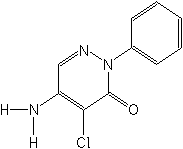-
Common NameChloridazon
-
中文通用名氯草敏
-
IUPAC5-amino-4-chloro-2-phenylpyridazin-3(2H)-one
-
CAS5-amino-4-chloro-2-phenyl-3(2H)-pyridazinone
-
CAS No.1698-60-8
-
Molecular FormulaC10H8ClN3O
-
Molecular Structure
-
Category
-
ActivityHerbicide
-
PremixSoluble concentrate, water dispersible granule, wettable powder. Premix Parters: metribuzin; thifensulfuron-methyl; tribenuron-methyl;
-
Physical PropertiesMolecular weight:221.6; Physical form:Colourless, odourless solid; (tech., brown, almost odourless solid). Density:1.54 (20 °C).; Melting point:206 °C ( tech., 198-202 °C); Vapour pressure:<0.01 mPa (20 °C); Henry constant:<6.52×10-6 Pa m3 mol-1 (calc.); Partition coefficient(n-octanol and water):logP = 1.19 (pH 7); Solubility:In distilled water 0.34 g/l (20 °C). In methanol 15.1, ethyl acetate 3.7, dichloromethane 1.9, toluene 0.1 (all in g/l, 20 °C). Practically insoluble in n-heptane.; Stability:Stable up to 50 °C for 2 years. Stable in aqueous media at pH 3-9. DT50 in simulated sunlight (xenon lamp, 2100 mEinstein m-2 s-1) 150 h (pH 7, water).
-
ToxicologyTech (Rat): Oral LD50 ca. 2200 mg/kg. Dermal LD50 >2000 mg/kg
-
Environmental ProfileEcotoxicology: Algae: EC50 (120 h) for Chlorella fusca 1.9 mg/l.Bees:Not toxic to bees; LD50 (48 h, oral and contact) >200
mg/bee.Birds:Acute oral LD50 for bobwhite quail >2000 mg/kg b.w. Dietary LC50 for bobwhite quail >5000, mallard ducks 4260 mg/kg. Daphnia: LC50 (48 h) 132 mg/l.Fish:LC50 (96 h) for trout 32-46 mg/l (trout), bluegill sunfish 93 mg/l.Worms: LC50 (14 d) for Eisenia foetida 1050 ppm. Environmental fate: Animals:In rats, following a single oral application, 85% is excreted in the urine within 1 hour, and 13% in the faeces. After repeated oral applications, excretion proceeds similarly, with 75% in the urine and 15% in the faeces.Soil:In soil, microbial degradation involves splitting off the phenyl group, to give 5-amino-4-chloropyridazin-3(2H)-one, which is not herbicidally-active (A. Fischer, Weed Res., 1962, 2, 177-184). Persists in soil for c.Plant:In beet, conjugation to form the N-glucosyl metabolite occurs. WATER SOLUBILITY: Low, 0.034 g/100g at 20°C. -
Transport InformationSignal Word:CAUTION; Hazard Class:III (Slightly hazardous)
Porduct NewsMore
Sumitomo Corp. acquires right from BASF to market herbicide chloridazon in Japan
Related CompaniesMore
Yingde Greatchem Chemicals Co., Ltd.
Country: China
Folpet Desmedipham Dazomet Captan Triticonazole Ipconazole Metconazole Boscalid Thifluzamide Ethofumesate
Shanghai Mingdou Chemical Co., Ltd.
Country: China
Atrazine Tribenuron-methyl Quizalofop-P-ethyl Paclobutrazol Glyphosate Emamectin benzoate Abamectin Paraquat Gibberellic acid GA3 Fipronil

 0
0 Subscribe
Subscribe
